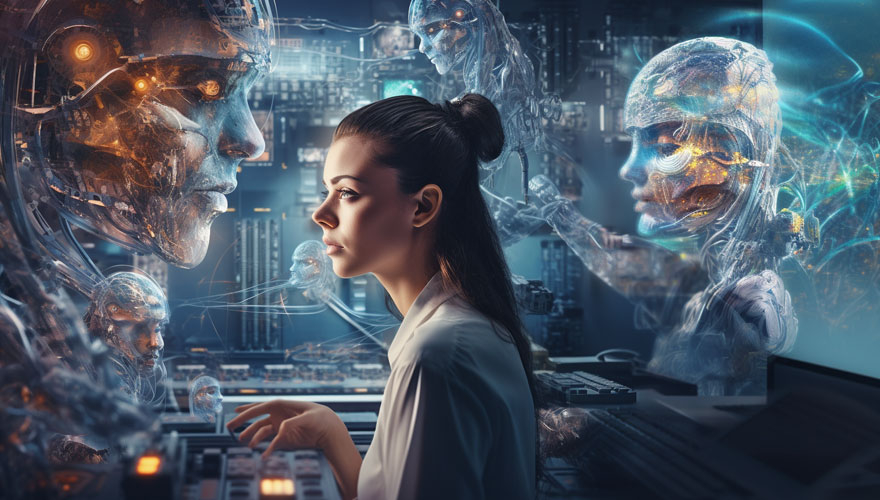In the ever-evolving landscape of technology and innovation, one term has been capturing the spotlight – “Gen AI.” It represents the next frontier of artificial intelligence, poised to revolutionize our approach to creativity and imagination. What exactly is Gen AI, and how will it transform our capacity for creativity and innovation?
Through our extensive research and collaboration with companies, academic institutions, governments, and military organizations on a myriad of innovation initiatives—some involving generative AI and others not—we’ve seen firsthand that this technology can help organizations overcome creativity challenges. Gen AI has the power to amplify the creativity of both employees and customers, enabling them to not only generate and identify novel ideas but also improve the quality of these concepts. Here are five compelling ways in which Gen AI is reshaping the creative landscape:
1. Fueling Divergent Thinking: Unleashing Imagination
Generative AI emerges as a powerful catalyst for divergent thinking, enabling associations among seemingly unrelated concepts and the generation of innovative ideas inspired by them. For instance, we harnessed the capabilities of Midjourney, a text-to-image algorithm, to produce novel product designs driven by textual prompts. When tasked with combining an elephant and a butterfly, it conjured a whimsical creation we aptly named “phantafly.” This intricate image served as inspiration for prompts in Stable Diffusion, another text-to-image model, which, in turn, spawned a multitude of innovative product ideas spanning various categories, from chairs to artisanal chocolate candies. This agile, cost-effective ideation process empowers companies to swiftly explore a wide array of product concepts, ensuring they stay nimble and in tune with evolving market trends.
Imagine the potential of connecting ideas to form concepts that might never emerge through conventional means. Employing ChatGPT, a generative AI model, we implemented a trisociation technique that links three distinct entities, leading to business ideas that merge “food,” “technology,” and “car” into a smart food-delivery service leveraging self-driving cars. This type of creative thinking can pave the way for groundbreaking solutions, reshaping industries and elevating user experiences.
2. Challenging Preconceptions: Beyond Expertise Bias
During the initial phases of new-product development, generative AI generates unconventional designs that challenge human preconceptions regarding what’s achievable. These atypical designs serve as a source of inspiration for designers, urging them to break free from traditional constraints and conceive solutions that may have otherwise remained unexplored. Generative AI is a potent tool for overcoming biases such as design fixation, functional fixedness, and the Einstellung effect. For instance, we tasked Stable Diffusion with crafting crab-inspired toy designs without specifying their functions. Subsequently, upon observing these designs, we imagined various functional possibilities, expanding the horizons of innovation.
3. Elevating Idea Evaluation: The Power of Objectivity
Generative AI tools are invaluable for enhancing the evaluation of ideas. They lend specificity to ideas, conduct objective evaluations, and even facilitate idea combination to yield more refined concepts. For example, ChatGPT conducted a comprehensive assessment of innovative ideas aimed at minimizing food waste, offering balanced and insightful analyses for each concept. This level of support in idea evaluation can substantially enhance the quality of ideas and streamline the decision-making process.
4. Nurturing Idea Refinement: A Collaborative Approach
Generative AI tools can tackle a critical challenge faced in idea contests: merging a multitude of ideas to generate much stronger ones. An organization vying for a contract or grant to develop a food-waste-reduction program can employ these tools to amalgamate the three aforementioned concepts. This can be achieved in two steps: first, asking ChatGPT to expand on each concept, providing detailed descriptions and explanations. Subsequently, multiple ideas can be synthesized into a robust, coherent proposal, expediting the innovation process.
5. Enabling Collaborative Creation: A User-Centric Approach
Generative AI introduces a new dimension of collaboration, facilitating interactions between businesses, designers, and end-users. Companies can empower users by providing tools for generating designs and personalizing products according to their preferences. Alternatively, users can submit their designs to a crowdsourcing platform, where the community evaluates and further develops top designs. This collaborative approach transforms the co-creation of new products, making it more accessible and cost-effective.
In conclusion, Gen AI is reshaping the landscape of creativity and innovation, offering the means to expand imaginative boundaries, challenge established biases, enhance idea evaluation, support idea refinement, and foster user collaboration. The future of innovation is intrinsically linked with the capabilities of generative AI. As we embark on this transformative journey, the potential for groundbreaking discoveries is boundless, with Gen AI serving as our indispensable partner in this exciting endeavor.



